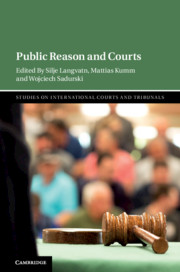42 results
Contents
-
- Book:
- Public Reason and Courts
- Published online:
- 22 May 2020
- Print publication:
- 04 June 2020, pp v-vi
-
- Chapter
- Export citation
Part II - Public Reason in International Courts and Tribunals
-
- Book:
- Public Reason and Courts
- Published online:
- 22 May 2020
- Print publication:
- 04 June 2020, pp 229-320
-
- Chapter
- Export citation
Copyright page
-
- Book:
- Public Reason and Courts
- Published online:
- 22 May 2020
- Print publication:
- 04 June 2020, pp iv-iv
-
- Chapter
- Export citation
Part I - Public Reason in Constitutional Courts
-
- Book:
- Public Reason and Courts
- Published online:
- 22 May 2020
- Print publication:
- 04 June 2020, pp 43-228
-
- Chapter
- Export citation
Index
-
- Book:
- Public Reason and Courts
- Published online:
- 22 May 2020
- Print publication:
- 04 June 2020, pp 350-368
-
- Chapter
- Export citation
Part III - Critical Perspective on Public Reason in Courts
-
- Book:
- Public Reason and Courts
- Published online:
- 22 May 2020
- Print publication:
- 04 June 2020, pp 321-349
-
- Chapter
- Export citation
Contributors
-
- Book:
- Public Reason and Courts
- Published online:
- 22 May 2020
- Print publication:
- 04 June 2020, pp vii-x
-
- Chapter
- Export citation
Preface
-
- Book:
- Public Reason and Courts
- Published online:
- 22 May 2020
- Print publication:
- 04 June 2020, pp xi-xxvi
-
- Chapter
- Export citation
6 - “We Hold These Truths to Be Self-Evident”: Constitutionalism, Public Reason, and Legitimate Authority
- from Part I - Public Reason in Constitutional Courts
-
-
- Book:
- Public Reason and Courts
- Published online:
- 22 May 2020
- Print publication:
- 04 June 2020, pp 143-163
-
- Chapter
- Export citation
Acknowledgments
-
- Book:
- Public Reason and Courts
- Published online:
- 22 May 2020
- Print publication:
- 04 June 2020, pp xxvii-xxviii
-
- Chapter
- Export citation

Public Reason and Courts
-
- Published online:
- 22 May 2020
- Print publication:
- 04 June 2020
Global Constitutionalism as agora: Interdisciplinary encounters, cultural recognition and global diversity – CORRIGENDUM
-
- Journal:
- Global Constitutionalism / Volume 8 / Issue 2 / July 2019
- Published online by Cambridge University Press:
- 13 June 2019, p. 424
-
- Article
-
- You have access
- HTML
- Export citation
Global Constitutionalism as agora: Interdisciplinary encounters, cultural recognition and global diversity
-
- Journal:
- Global Constitutionalism / Volume 8 / Issue 1 / March 2019
- Published online by Cambridge University Press:
- 07 March 2019, pp. 1-11
-
- Article
-
- You have access
- HTML
- Export citation
Who is Afraid of the Total Constitution? Constitutional Rights as Principles and the Constitutionalization of Private Law
-
- Journal:
- German Law Journal / Volume 7 / Issue 4 / 01 April 2006
- Published online by Cambridge University Press:
- 06 March 2019, pp. 341-369
-
- Article
-
- You have access
- Export citation
The Idea of Thick Constitutional Patriotism and Its Implications for the Role and Structure of European Legal History
-
- Journal:
- German Law Journal / Volume 6 / Issue 2 / 01 February 2005
- Published online by Cambridge University Press:
- 06 March 2019, pp. 319-354
-
- Article
-
- You have access
- Export citation
Rebel Without a Good Cause: Karlsruhe's Misguided Attempt to Draw the CJEU into a Game of “Chicken” and What the CJEU Might do About It
-
- Journal:
- German Law Journal / Volume 15 / Issue 2 / 01 March 2014
- Published online by Cambridge University Press:
- 06 March 2019, pp. 203-215
-
- Article
-
- You have access
- Export citation
12 - On the Representativeness of Constitutional Courts
- from Part III - Legitimacy, Effectiveness, and Judicial Methods of Decision-Making
-
-
- Book:
- Judicial Power
- Published online:
- 27 January 2019
- Print publication:
- 07 February 2019, pp 281-291
-
- Chapter
- Export citation
Index
-
- Book:
- Global Constitutionalism from European and East Asian Perspectives
- Published online:
- 09 November 2018
- Print publication:
- 29 November 2018, pp 572-608
-
- Chapter
- Export citation
Acknowledgments
-
- Book:
- Global Constitutionalism from European and East Asian Perspectives
- Published online:
- 09 November 2018
- Print publication:
- 29 November 2018, pp xiv-xvi
-
- Chapter
- Export citation
Part II - Pursuit of Common Values
-
- Book:
- Global Constitutionalism from European and East Asian Perspectives
- Published online:
- 09 November 2018
- Print publication:
- 29 November 2018, pp 201-274
-
- Chapter
- Export citation

